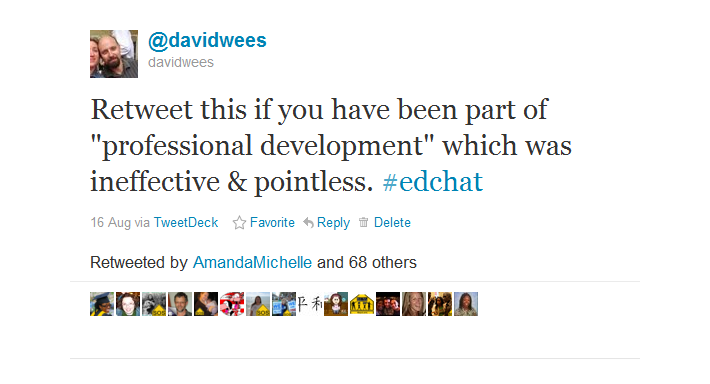I’m looking for feedback on the document started below. What recommendations would you make to change teacher education programs?
Objective
Put some thoughts together on the implications of the technological literacy of students arriving at our schools for both teacher education and professional practice. What do our teacher education programs need to do to prepare teachers to teach kids who arrive at school knowing how to make movies? What new thinking do we need about how we educate teachers in preparation for certification and how teachers currently holding certificates need to direct their life-long learning?
What is already being done?
5 out of 9 of the colleges in British Columbia have an optional educational technology course already as of January 2010. See this spreadsheet for details. No colleges require educational technology be learned by teachers, although some colleges do at least require some use of technology by teachers.
Thoughts
Two main ideas:
1. Teach teachers how to use specific technologies
- Teachers arrive with very different skill levels themselves.
- Schools have different levels of access to technology, so student teachers may not be able to use it during their practicum.
- Teachers should learn enough about technology that they can teach themselves future skills.
- Teachers should use technology to connect themselves with other educators.
- Teachers should understand & know some of the research behind different types of media and their effect on learning.
2. Teach teachers why they would want to use technology in the classroom
- Teachers should know how to evaluate educational technologies
- Teachers should understand philosophy of educational technology
- Teachers should know some of the history of educational technology
Rational
As with any other skill in teacher education programs, the use of technology by teacher candidates varies greatly.
A variety of different technologies should be included as access to any given technology may be limited at schools. Some schools limit access by policy intended to safeguard children and/or monitor teachers. Other schools have limited access because of budgetary concerns. Either way, teachers may not have full access to their preferred choice of technology, so they should know enough technology that they can use it flexibly.
Given the importance of technology in today’s world, teachers should understand the purposes of educational technology, and how to incorporate it into their classroom practice. Relatively simple processes, like the SECTIONS framework (Bates and Poole, 2003, see this PDF for an example implementation), can be used to evaluate new technologies and decide on their utility in a classroom setting.
Educational technology, just like other technologies, is rapidly changing, following the trend of the exponential change in technology as per Moore’s Law. This means that, in order for teachers (and by extension schools) to remain current, teachers must be able to learn new technologies and make decisions about whether they will be useful. Teacher education programs must prepare teachers not just to use today’s technology, but how to learn the technology of
tomorrow.
Further, technology exists today that is freely available and easy to use, which allows teachers to connect with each other like never before. Social media has the potential to break down the walls of the classroom and provide teachers with the opportunity to share their practice widely. Teachers should learn how to use social media as it is not only a way for them to keep current in their practice, it is also a way for the already existing excellent practices in education to spread. Just as it is the expectation that doctors will keep themselves current by connecting with other medical professionals in the field, so too should educators.
Educators need to learn how to share their ideas openly. For example, the use of Creative Commons licensing, should be wide-spread in our profession so that, while attribution remains similarly important, we can ground the existing sharing of materials in a supportive legal framework.
However, without knowing the history of educational technology, teachers are more likely to fall into the same pitfalls as others before them. It is easy to use technology in a classroom and have a room full of students who are actively engaged in pseudo-learning rather than real learning. Technology used only for the purpose of engaging or entertaining students is not a good use of technology, nor an example of good teaching practices.
It is important that the use of educational technology be grounded in good pedagogy. Teachers need a deep understanding of constructivism before they can use technology effectively as a constructivist tool for learning. Teachers need to understand that just being exposed to an idea does not mean that students will learn it, and the same is true of technology. The use of multimedia in classrooms has traditionally been to deliver content (or to entertain students) and teachers should recognize the power of multimedia to enhance the understanding of students, but also the danger in changing one ineffective practice (lecture) into another ineffective practice (video lecture).
Teachers should learn about how to facilitate the student use of technology so that students, who are often exposed to the language and vocabulary of technology at an early age, are able to actively use technology rather than just be passive recipients of the teacher’s use of technology.
Specific Recommendations
- Teacher education programs need to include a history, philosophy, and practical use of educational technology course.
- Educational technology learning at teacher colleges should be grounded in research, pedagogy, and use current technologies.
- The technology should be taught to teachers in the same ways we would like teachers to teach.
- Professional development should be available continuously to teachers so they can keep their knowledge current.


